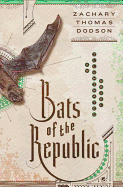
| Publisher: | Doubleday | |
| Genre: | Science Fiction, Fiction, Action & Adventure, Literary, Apocalyptic & Post-Apocalyptic | |
| ISBN: | 9780385539838 | |
| Pub Date: | October 2015 | |
| Price: | $27.95 |
| Fiction |
by Zachary Thomas Dodson
Zachary Thomas Dodson's first novel feels destined to make a splash with its sprawling combination of science fiction and mysticism, art and text, western and dystopia.
In the year 2143, Americans live in city-states divided by life stages. The government records all conversation. Paper is forbidden, although "carbons" of paper documents are housed in a vast archive called the Vault of Records, a supposed safe house for history and culture. Zeke and his girlfriend, Eliza Gray, live in the Republic of Texas, where young adults meet their spouses. Zeke's grandfather Zadock has recently passed away in Chicago-Land, where senior citizens reside, and Zeke stands to inherit his grandfather's seat in the Senate. However, he also inherits an ancient, sealed envelope. By law, he must turn it in to the Vault for copying without opening it, but when he hesitates, everything he holds dear comes under threat.
Dodson should find plenty of fans among readers who prefer stories that challenge them to think deeply and keep up, even if their adventures require a bit of stumbling along darkened paths. His future Republic of Texas is imagined clearly enough to make it seem as real as the bat caves and yawning deserts of the 1843 Texan landscape. While he delves into the realm of steampunk, Dodson leaves out many of the Victorian fripperies common to the genre and focuses on the implications of a society powered at least partly on steam.
He has filled a puzzle box of a novel with beautiful art and astounding breadth of imagination, and the result begs to be opened. --Jaclyn Fulwood, blogger at Infinite Reads
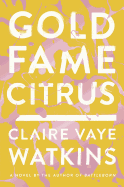
| Publisher: | Riverhead | |
| Genre: | Political, Fiction, Dystopian, Literary | |
| ISBN: | 9781594634239 | |
| Pub Date: | September 2015 | |
| Price: | $27.95 |
| Fiction |
by Claire Vaye Watkins
Gold Fame Citrus, Claire Vaye Watkins's debut novel (following her much-acclaimed short story collection, Battleborn), introduces readers to Southern California in the near future--a region in which extensive drought has permanently altered both the physical and social landscape. The land is mostly deserted but for a handful of holdouts: those unable to afford evacuation and those unwelcome in the more fertile areas of the United States. In this barren, empty place live Luz and Ray, camping out in the abandoned mansion of a former starlet. When the two encounter a strange young girl on a foraging trip, their lives--and their love--shifts in unexpected ways, sending the two on a journey across the hostile, hardened lands of the southwestern United States.
Watkins writes in prose that borders on poetry, capturing both the hardness and the beauty of her imagined landscape in ways that make each page of her novel sing with a sense of place. "Clear--whatever color you want it to be. The color of diamonds kissed by light. Bathe in it, fling it into the air, carpet the desert in Bermuda and Buffalo and Kentucky blue." These powerful, flowing descriptions prove even more compelling as a mirror for a series of nuanced, flawed and fascinating characters--ones who struggle through an apocalyptic world both external and internal. Gold Fame Citrus builds in intensity and emotion as it progresses, creating a moving American epic that explores the role stories, place and our closest relationships serve in shaping our selves. --Kerry McHugh, blogger at Entomology of a Bookworm
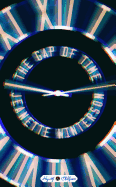
| Publisher: | Hogarth Shakespeare | |
| Genre: | Humorous, Classics, Fiction, Contemporary Women, Literary | |
| ISBN: | 9780804141352 | |
| Pub Date: | October 2015 | |
| Price: | $25 |
| Fiction |
by Jeanette Winterson
The Hogarth Shakespeare project undertakes to reinvent the Bard's classic works in novel form; the first installment is The Gap of Time by Jeanette Winterson (Why Be Happy When You Could Be Normal?), a "cover version" of The Winter's Tale. In Shakespeare's original, the kings of Sicily and Bohemia are great friends until one accuses the other of sleeping with his wife.
The Gap of Time is set both in London, just following the 2008 economic crisis, and the fictional American city of New Bohemia. Londoners Leo and Xeno were childhood friends and, for a time, lovers; as adults, despite very different values, the bohemian Xeno and the materialistic Leo have become business partners in Sicilia, a high-tech gaming company. Leo's wife, MiMi, son, Milo, and his uber-capable assistant, Pauline, round out a highly functional, loving family of sorts, until Leo becomes obsessed with the idea that MiMi and Xeno are sleeping together. Leo reacts violently, and loses his son and wife. When he tries to ship MiMi's baby daughter overseas to Xeno, whom he wrongly believes to be her father, the little girl goes missing.
As the title indicates, Winterson's version of The Winter's Tale plays with the concept of time even more than the original did, asking questions about what is changeable about our pasts and our futures. This is a stirring tale filled with waste, simple mistakes and regrets. But as in the original, it also offers hope, young love and the possibility of new beginnings. --Julia Jenkins

| Publisher: | Little, Brown | |
| Genre: | General, Fiction, Family Life, Historical | |
| ISBN: | 9780316300391 | |
| Pub Date: | September 2015 | |
| Price: | $26 |
| Fiction |
by Virginia Baily
In October of 1943, Chiara Ravello makes eye contact with a stranger, a Jewish mother being forced by the Nazis into a truck with her family and other Jews. Giving almost no thought to her actions, Chiara cries out that the woman's seven-year-old son, Daniele, is her nephew. He should be released to her.
Once he is, Chiara realizes she's saddled herself with the responsibility of a little boy in the midst of a devastatingly dangerous war.
Thirty years later, Chiara receives a letter from a Welsh teenager claiming to be Daniele's daughter. The girl's mother hid her father's identity until recently, and now she's desperate to learn what she can about her biological parent. The contact is jarring to Chiara, who has not seen Daniele in many years. She doesn't know if the man she once took in as her own child is even alive. Chiara locked away her love for Daniele, forced by circumstances to accept its agonizing conditions of disappointment and betrayal. But his daughter is unrelenting, so Chiara decides the time is right to face that love and all of its baggage once again.
Virginia Baily (Africa Junction) tells Chiara and Daniele's heartbreaking story by alternating between the fall of 1943 and the spring of 1973. She doles it out in small doses, allowing the reader to digest slowly the individual struggles at a time when the world seemed to be falling apart around them.
A complex exploration of identity, a tribute to love in its many shapes and sizes, Early One Morning shapes beauty from pain while compassionately touching its readers' hearts. --Jen Forbus of Jen's Book Thoughts
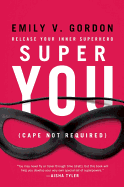
| Publisher: | Seal Press | |
| Genre: | Self-Esteem, Self-Help, Motivational & Inspirational, Personal Growth | |
| ISBN: | 9781580055758 | |
| Pub Date: | September 2015 | |
| Price: | $16 |
| Psychology & Self-Help |
by Emily V. Gordon
Every hero has an origin story, whether it's witnessing a parent's murder (Batman) or leaving the safety of home for love and justice (Wonder Woman). It is survival of that traumatic event that gives superheroes their strength to battle on, and it is a metaphor that former couples' and family therapist, stand-up comic and writer Emily V. Gordon uses to create a "Super You," the best version of self that a person can achieve at any given moment.
Using her experience treating self-esteem issues in adolescents, Gordon distills the myth of the superhero into tools and techniques that the average Joe can apply toward his or her own personal transformation. Rather than abstract goals that get ignored, she advises readers to create narrower "secret missions," baby steps of achievable goals that turn weaknesses into weapons "to fight internal crime, and be on the side of justice and well-being." Once she lays the foundations of personal responsibilities and choices, Gordon provides a "utility belt" of tricks to help readers boost and build positive self-esteem.
Gordon never comes across as too clinical or condescending in her advice; instead, she adopts a humorous, empathetic and sisterly tone in conveying her message, using her own insecurities and neuroses to demonstrate how even less-than-desirable qualities can be harnessed as superpowers.
"Creating a Super You isn't about eradicating all weaknesses," writes Gordon. "Some weaknesses deserve to be cradled and considered part of the charming package that is you, some weaknesses can be improved upon for your overall health, and some weaknesses can be reframed and made more useful to you." --Nancy Powell, freelance writer and technical consultant
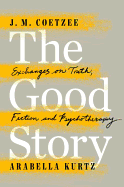
| Publisher: | Viking | |
| Genre: | Literary Criticism, Literary Collections, General, Books & Reading, Biography & Autobiography, Psychology, Psychotherapy, Essays, Self-Help, Literary | |
| ISBN: | 9780525429517 | |
| Pub Date: | September 2015 | |
| Price: | $27.95 |
| Psychology & Self-Help |
by J.M. Coetzee, Arabella Kurtz
In his novels, J.M. Coetzee (The Childhood of Jesus) regularly explores how characters might invent and reinvent themselves in their social classes, their politics and their religions. With The Good Story: Exchanges on Truth, Fiction and Psychotherapy, Coetzee has decided to lift the curtain of fiction and attack questions of identity head on.
Through transcribed conversations with noted clinical psychologist Arabella Kurtz, the two begin to piece together an argument for fiction's place in the human psyche. Coetzee turns the tables on himself and asks of Kurtz whether or not everyone--award-winning novelist or not--is a writer of fiction. What starts as Coetzee corresponding with a friend about his own interest in using psychology to build characters quickly expands to include long-debated theoretical concepts.
A patient will see a therapist like Kurtz, Coetzee says, with deeply held ideas about themselves. Is it the job of the therapist to reveal their self-deceptions or to validate them? Is objective truth even possible if memory is so faulty?
"My inclination," Coetzee writes to Kurtz, "is to regard the stories that artists tell about themselves as much like the stories the rest of us tell about ourselves: they serve our own interests." Kurtz responds, "The stories we tell about our lives may not be an accurate reflection of what really happened, indeed they may be more remarkable for their inaccuracies than anything else.... But they are simply all we have to work with."
In the course of the book, the two giants of their respective field leave no stone unturned when it comes to fiction, psychology and philosophy. --Josh Potter
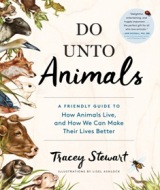
| Publisher: | Artisan | |
| Genre: | Agriculture, Animals, Pets, General, Technology & Engineering, Animal Husbandry, Nature | |
| ISBN: | 9781579656232 | |
| Pub Date: | October 2015 | |
| Price: | $19.95 |
| Nature & Environment |
by Tracey Stewart, illust. by Lisel Ashlock
Tracey Stewart was born to love animals: "There are pictures of my mother pregnant with me, a bird on her head, a rabbit in her arms, and a dog at her feet." Her heart yearned to become a veterinarian, but a talent for art led to a variety of design jobs, including architecture and lingerie. Eventually she followed her passion for animals and became a veterinary technician, and she and her children volunteered at the local animal shelter helping homeless pets find "forever homes." Then she and her husband, Jon Stewart, set up a farm animal rehabilitation center in rural New Jersey. In Do Unto Animals, Stewart hopes the spirit of the Golden Rule will "inspire all animal lovers to learn a little more and do a little more."
Stewart demonstrates how to understand domesticated animals' body language by using beautiful illustrations to help readers interpret and identify calming signals (for example, an averted gaze, lip licking and yawning indicate a dog's desire to appease). She explains why docking a dog's ears and tail and removing a cat's claws are misguided, and provides concrete suggestions for discouraging the practice. Do Unto Animals highlights why a diverse gene pool is healthy, and convincingly explains why shelter animals can be the very best pets, clarifying why pitbulls and black cats are over-represented in shelters. In addition to the practical information, she offers fun DIY toys and beds as well as interactive games. Do Unto Animals is a wonderful hands-on resource for animal lovers of all ages. --Kristen Galles from Book Club Classics
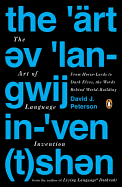
| Publisher: | Penguin Books | |
| Genre: | Literary Criticism, General, Alphabets & Writing Systems, Language Arts & Disciplines, Science Fiction & Fantasy, Composition & Creative Writing | |
| ISBN: | 9780143126461 | |
| Pub Date: | September 2015 | |
| Price: | $17 |
| Reference & Writing |
by David J. Peterson
What do Star Trek's Klingon, J.R.R. Tolkien's Elvish and Game of Thrones' Dothraki have in common? They are fully functioning languages constructed by humans for fictional purposes, each imbued with a complex system of sounds, words, grammar and an evolving linguistic history. How these conlangs (constructed languages) came to exist on the page and on both the small and big screens is the topic of linguist and master language creator David J. Peterson's (Living Language Dothraki) book The Art of Language Invention, a layperson's crash course on the science and art of linguistics.
Peterson analyzes and discusses the elements critical to the creation of natural languages--sound structures and syllabaries, words and word units, grammar, language growth and written structure. He uses examples drawn from his own invented conlangs--Irathient (SyFy's Defiance), Shiväisith (Marvel's Thor: The Dark World), Dothraki and Valyrian (HBO's Game of Thrones)--to illustrate important linguistic concepts and provide concrete tools for those interested in pursuing conlang development. Peterson talks about the difficulties inherent in such an endeavor, and discusses the culture of conlangers and the compromises they must make in order to please studio bosses who want something recognizable and pleasing to viewers.
The Art of Language Creation is by no means light reading. While Peterson does an admirable job simplifying linguistic principles for the average Joe, creating a credible, working and breathing language requires the mastery of key fundamentals, and this demands serious study by readers.
"Once you know the science," writes Peterson, "then you can apply your knowledge of language to the being you've created and build on top of it." --Nancy Powell, freelance writer and technical consultant
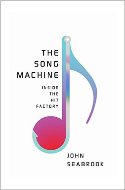
| Publisher: | W.W. Norton | |
| Genre: | Performing Arts, Pop Vocal, General, Social Science, Music, Popular Culture, Business Aspects, Genres & Styles | |
| ISBN: | 9780393241921 | |
| Pub Date: | October 2015 | |
| Price: | $26.95 |
| Starred | Performing Arts |
by John Seabrook
New Yorker writer John Seabrook (Flash of Genius) provides an eminently readable and important inside look at how the pop music industry developed strategies to manufacture no-fail hit songs.
Seabrook's in-depth interviews with an army of songwriters, producers, performers and others make for series of profiles that document a revolution in the music business. He chronicles everything from the emergence of new business models to the deliberate interjection of hooks meant to re-engage listeners every seven seconds, the average amount of time people listen to a song before they change the station. Including optimal chord progressions and the most effective camera angles for videos, these strategies exploit the brain's reflexive attraction to repetition, rhythm and melody. Hit factories now create formula-driven, synthetic tracks with near-universal appeal, producing songs that combine beat-driven dance music with the pop that people enjoy on the radio.
The Song Machine is a superbly written, textured account of a creative industry still in flux, one where an artist's creative vision is no match for a deadly effective business machine. As streaming replaces CD sales and contemporary hits replace album-oriented music, and 1% of artists now generate 80% of the industry's profit, the role of the singer and writer has radically changed. Seabrook acknowledges the addictive appeal of such music while remaining troubled by the cost: music that can be performed by anyone is inherently soulless, even if it can foster brief moments of connection between Seabrook and his children when they are captured by a song's seductive hooks. --Jeanette Zwart, freelance writer and reviewer

| Publisher: | Hardie Grant Books | |
| Genre: | Collections, Catalogs, Exhibitions, Pets, General, Dogs, Photoessays & Documentaries, Photography | |
| ISBN: | 9781784880057 | |
| Pub Date: | September 2015 | |
| Price: | $24.95 |
| Starred | Art & Photography |
by Elke Vogelsang
While dog books litter bookstore shelves--cute, poignant or educational--Nice Nosing You stands apart. "A declaration of love for three rescue dogs who became life-savers, beloved family members and photo models," German photographer Elke Vogelsang's first book is a thank-you to the two of the family's three rescue dogs who saved her husband's life on Christmas Day, 2009. (Ioli, the one-eyed smallest one, joined the family as a foster dog two years later, and was invited to stay.)
Noodles (a Spanish sighthound, in the cover's center) and Scout (the buff-colored sighthound mix) were barking and agitated. When Vogelsang followed them, she found her husband, Carsten, unconscious. Doctors declared him "moribund," and for months he struggled to recover from a brain aneurysm and resulting strokes. "To have a creative outlet to cope with the nerve-wracking pressure" of Carsten's uncertain future, Vogelsang began a "picture a day" project.
Carsten eventually recovered fully, and Vogelsang's photo diary prompted a career change, from translator to photographer. Nice Nosing You, in a comfortable 10" x 7" format, sandwiches technically stunning photos with dog-centric quotes from famous people. Noodles, Scout and Ioli are posed in the studio, captured in nature, and shot in playful drapes of clothing. "Nosing" shots, featuring their distinctive black schnozzes, add humor. A final image is a lovely portrait of a hardy-looking Carsten with the dogs.
An index of thumbnails of each photo includes whimsical captions and specifics of cameras and parameters Vogelsang used, intended to be "helpful with your own photography work." Other photographers might hope for her eye and heart, as well. --Cheryl Krocker McKeon, manager, Book Passage, San Francisco

| Publisher: | Simon & Schuster | |
| Genre: | New Baby, Social Issues, Juvenile Fiction, Family, Special Needs | |
| ISBN: | 9781481432320 | |
| Pub Date: | October 2015 | |
| Price: | $16.99 |
| Starred | Children's & Young Adult |
by Kenneth Oppel, illust. by Jon Klassen
"Nest" is supposed to be a cozy sort of word, but not in The Nest, a chilling nailbiter from Printz Honor author Kenneth Oppel (Airborn).
Steven is an anxious boy. He worries about everything, most of all his sickly baby brother, Theo, who has a congenital disease no one can quite figure out. At first, Steven thinks he's being visited in his sleep by gossamer-winged angels, haloed by light. But these are no angels. They materialize to Steven as silvery human-sized wasps, announcing that they've decided to replace the sickly Theo with a perfect, healthy baby, and that they need his help. Steven is confused as to what to do, because his family is a wreck, but it doesn't take long for him to realize that perfection isn't real, nor even desirable. Could the wasps "fix" him, too, then? Make him less compulsive and fearful? If they did that, would he still be himself? What would be the cost? The wasps pull Steven into a world that goes even deeper than DNA, burrowing into human existence on a mitochondria-level. But manufacturing "perfection" starts to look sinister indeed, and readers are challenged to examine questions about what "normal" is and, indirectly, the ethics of genetic engineering, all in the guise of a fantastical thriller.
Caldecott artist Jon Klassen's (This Is Not My Hat, Sam & Dave Dig a Hole) moody graphite illustrations help build the sense of horror, and wasps hover over chapter openers in disturbingly larger numbers as Steven's internal struggle escalates to a full-on, real-life battle for survival. --Karin Snelson, children's and YA editor, Shelf Awareness
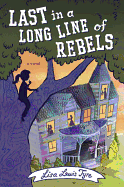
| Publisher: | Nancy Paulsen/Penguin | |
| Genre: | Prejudice & Racism, Lifestyles, Mysteries, Espionage, & Detective Stories, Social Issues, United States - Civil War Period (1850-1877), Juvenile Fiction, Historical, Country Life | |
| ISBN: | 9780399168383 | |
| Pub Date: | September 2015 | |
| Price: | $16.99 |
| Children's & Young Adult |
by Lisa Lewis Tyre
Lisa Lewis Tyre's debut novel, Last in a Long Line of Rebels, skillfully combines Civil War history and a modern-day mystery.
Twelve-year-old Lou Mayhew's 175-year-old family home in Tennessee is much loved, but looks "like something out of an R.L. Stine story." When Lou discovers it might be torn down, she works with three friends to save it, possibly by registering it as a "Historic Place." After all, the house may have been inhabited by gold thieves and, according to visiting historian George Neely, a murderer. Worst of all for Lou, she learns there are old slave quarters in her own backyard. "Try to look at it as a puzzle," Mr. Neely tells Lou. "Your ancestors left you a great mystery to solve." Puzzle pieces keep popping up, including an old box containing the Civil War-era diary of Lou's namesake, Louise Duncan. In it, Lou reads that Louise was proud of her beau, Walter Mayhew, for guarding gold for the Confederacy. But gradually, Louise realized the cost of the war to the community and became opposed to slavery. Meanwhile, Lou sees first-hand that prejudice is still alive in 1999 Tennessee when her friend Isaac, a talented athlete, is denied a university scholarship because he is black.
Lou decides that if Isaac is brave enough to fight that, and her namesake was brave enough to fight slavery, she's not going to give up on trying to save her family's house. Thanks to Lou's lively, first-person narration and her entertaining, loyal team of friends, readers will be glad to be along for the ride. --Cathy Berner, Blue Willow Bookshop, Houston, Tex.
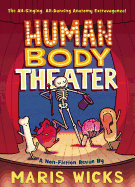
| Publisher: | First Second/Roaring Brook | |
| Genre: | Science & Nature, Anatomy & Physiology, Juvenile Nonfiction, General, Comics & Graphic Novels | |
| ISBN: | 9781596439290 | |
| Pub Date: | October 2015 | |
| Price: | $14.99 |
| Children's & Young Adult |
by Maris Wicks
Human Body Theater is an ambitious, impressively substantive primer in human anatomy by Maris Wicks (Science Comics; Primates), a comic book-style "nonfiction revue" in 11 acts, hosted by a female human skeleton (and shameless punster).
On a curtained stage, this energetic revue begins as the skeleton reveals that it's really the cells, molecules and atoms that run the show, but Act One is the skeletal system, starring "BONES!" Quick... how many bones are in the adult human body? 206! What's the largest bone? Femur! Smallest? The stapes. (It's in the ear.) Straightforward, labeled anatomical diagrams abound, as do happy-faced body components and cartoon-bubble groaners, such as "Socket to me!" near the eye socket.
Act Two is the muscular system, and the master of ceremonies now looks like she's wearing a meat suit, which she removes to reveal her lungs for Act Three, the respiratory system. With just the right blend of silliness and scholarship, the skeleton marches readers through the rest of the body's essential systems: cardiovascular ("Beep! Beep! All aboard the blood bus!"), digestive, excretory--intermission here after all the bladder talk--endocrine, reproductive (all fairly clinical, as fertilization is illustrated on the cartoon sperm to egg level), immune and nervous systems, with Act Eleven as "Smell, Taste, Hearing, Sight and Touch." Along the way, Wicks sheds light on sneezing, yawning, hiccups, headaches, scabs, nutrition, allergies, hand-washing, hydration, burping, manners!, exercise, immunizations, asthma, puberty, colds and much, much more.
Like a pancreas to sugars, Human Body Theater breaks down a vast amount of information to make it more... digestible. --Karin Snelson, children's and YA editor, Shelf Awareness